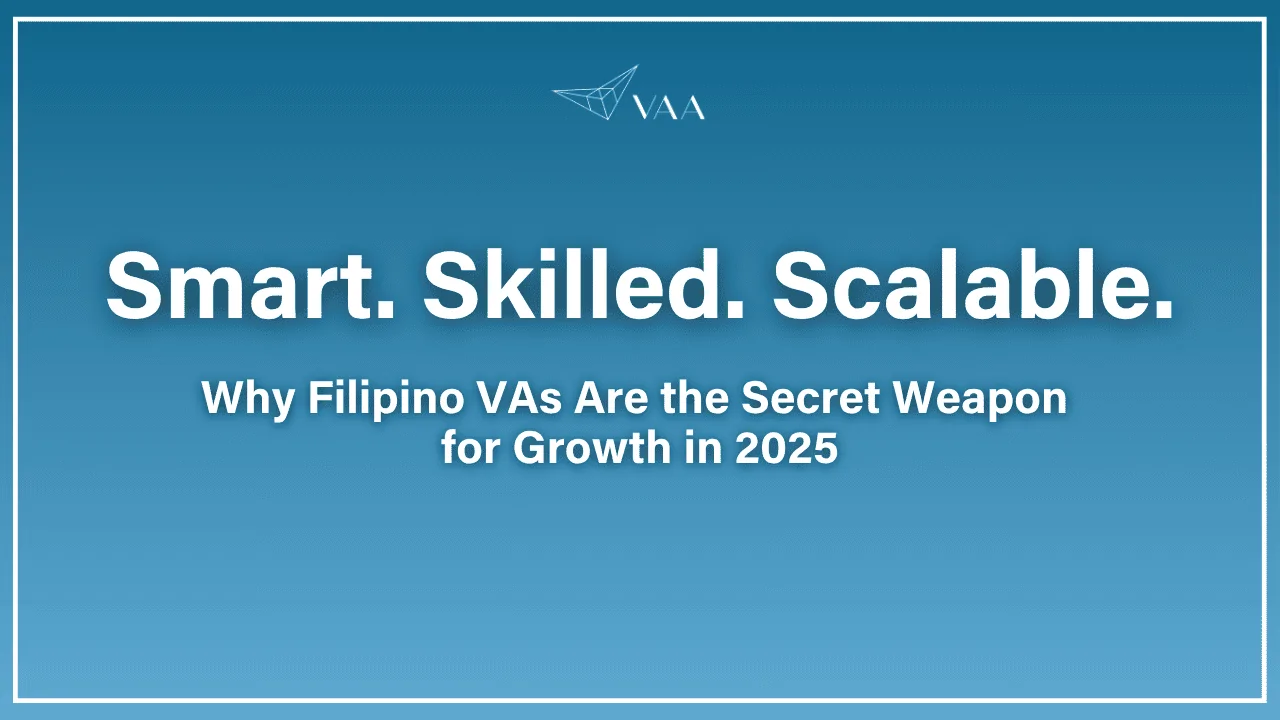
Virtual assistants (VAs) have moved from behind-the-scenes support to being central players in business growth. As more companies embrace remote-first operations, the demand for high-performing VAs continues to rise, and hiring a virtual assistant in the Philippines is quickly becoming a go-to strategy for scaling businesses.
The virtual assistant Philippines industry has become a global hub for business owners seeking reliable, affordable support, especially for entrepreneurs focused on sustainable growth.
So, what sets them apart? Here are ten reasons why hiring a virtual assistant from the Philippines may be a smart move for you in 2025.
English is one of the Philippines’ official languages, and it is used in education, media, and business. In 2024, the Philippines ranked twenty-second globally and second in Asia for English proficiency, according to the EF English Proficiency Index. This level of fluency allows Filipino VAs to communicate clearly with international clients and customers.
For example, a business owner might rely on a VA to write product descriptions, respond to customer messages, or draft email campaigns—confident that the language will be natural and professional, with little need for revision.
Filipino professionals are widely recognized for being diligent, dependable, and respectful. These traits are deeply embedded in the country’s culture, making Filipino VAs valuable team members who take their responsibilities seriously and often show initiative.
In practice, this can translate to your Filipino VA monitoring key business metrics and highlighting important trends during a weekly report, without being asked. Their proactive mindset adds an extra layer of dependability that many business owners find refreshing.
Due to strong cultural exposure to the West, VAs in the Philippines are familiar with the communication styles and business tools used by clients in countries like the United States, Australia, and the United Kingdom. Many VAs already use platforms like Slack, Shopify, and Trello, among many others, before joining a new team.
This cultural alignment helps eliminate awkward onboarding or overexplaining, making it easier to delegate tasks confidently and build strong working relationships from day one.
Hiring a virtual assistant in the Philippines allows businesses to access skilled talent at significantly lower rates than hiring locally. While a VA based in North America might charge between twenty-five and fifty dollars per hour, Filipino VAs often offer services between six and fifteen dollars per hour, depending on their experience and specialization.
This price range makes it possible for a growing business to hire multiple support roles. For example, one VA for customer service, one for product research, and one for marketing, while still keeping labor costs manageable.
Filipino VAs often come with experience across multiple platforms and functions, allowing them to wear many hats as your business grows. Many VAs already have hands-on knowledge of tools like Canva, Amazon Seller Central, Helium 10, and CRM platforms from previous experiences or online courses.
A business owner may start by delegating basic administrative tasks but later discover that their VA is also capable of handling customer follow-ups, managing email newsletters, or even helping with ad campaign coordination. This adaptability helps reduce the need for multiple hires.
With over 700,000 college graduates each year, the Philippines has a large, educated talent pool. Many VAs come from backgrounds in marketing, business, or information technology. In addition, some have gone through advanced VA-specific training, such as training provided by agencies like VAA Philippines, a leading name in the virtual assistant Philippines space, which focuses on skills like listing optimization, PPC campaign management, and Amazon FBA workflows.
This means you can find candidates who are not only familiar with your tools but also understand your industry, reducing ramp-up time.
Virtual assistants in the Philippines are increasingly investing in reliable work setups, including high-speed internet, backup connections, and dedicated home office spaces. In major cities like Manila and Davao, improved infrastructure makes it easier for remote professionals to maintain consistent productivity.
Filipino VAs often belong to online communities where they engage in peer learning, share productivity tips, and attend free or low-cost webinars. This habit of continuous learning makes them more resourceful and proactive in staying current with new tools and techniques.
Filipino VAs are accustomed to adjusting their work schedules for international clients. Whether you operate in the United States, the United Kingdom, or Australia, you can find a VA willing to work during your business hours or provide after-hours coverage.
Especially for online businesses like running an Amazon store, this flexibility could mean your VA is handling customer inquiries, refund requests, or social media responses while you sleep, so your brand remains responsive and active 24/7.
Filipino VAs—and professionals in the broader virtual assistant Philippines talent pool—are widely used in sectors like Amazon, real estate, SaaS, and digital marketing.
For example, a VA might initially provide support with data entry but eventually take ownership of reporting or customer engagement initiatives, helping the business scale without increasing headcount.

The Philippine outsourcing industry is expected to reach 40 billion dollars by the end of 2025. Filipino VAs bring together affordability, professionalism, flexibility, and a strong work ethic, making them ideal partners for businesses looking to grow sustainably.
If you are ready to scale your business while reducing operational stress, working with a Filipino VA—or a trusted virtual assistant in the Philippines—is a smart place to start. VAA Philippines connects business owners with Amazon-trained virtual assistants who specialize in customer service, product research, PPC, and listing optimization. Every VA is carefully selected and receives training to stay aligned with Amazon’s tools and evolving standards.